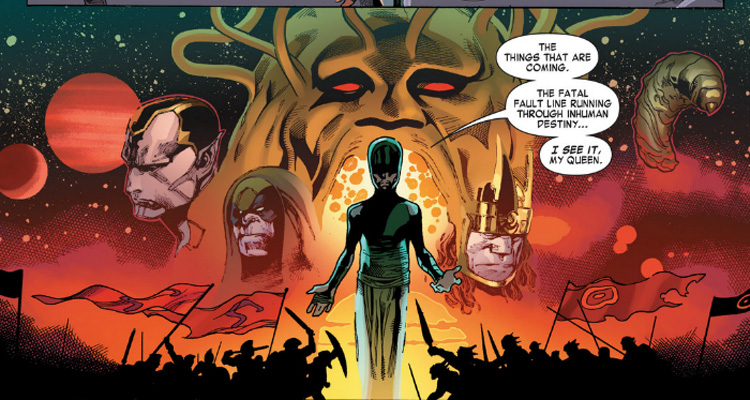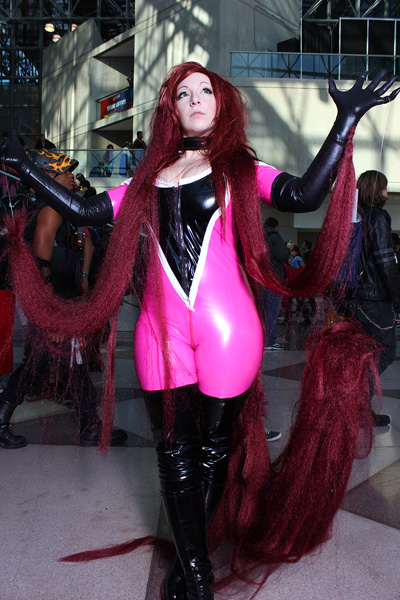Marvel Shows Long-game Strategy with ‘Inhumans’ No. 1

I am a fan of big thinkers — people who take big risks and implement long-game strategies. Which is why I am fan of Marvel and its new comic Inhumanity. This new title may be the keystone in an enormous arch that goes way beyond Marvel’s comic books.
First though, a little history. And be warned, eventually I will get into spoilers if you haven’t read the Infinity mini-series or Inhumanity No. 1.
Marvel isn’t just comics, of course, and Marvel Studios has had huge hits within the successful franchise of superhero movies that all led to the monster hit “Marvel’s The Avengers.” The pathway from the first Iron Man movie to “The Avengers” wasn’t a coincidence — Marvel had the path mapped out in great detail. That kind of long-term strategy is one of the reasons why Disney came calling and acquired Marvel.
But Disney didn’t just buy Marvel Studios, it bought the whole shebang; Marvel Comics as well. Because Marvel Comics is where the decades of intellectual property that will fill the Marvel Studios movies resides.
The success of the movies led Marvel to reset all of its major titles with new volumes and new No 1 issues, in the event called MarvelNOW! That event allowed Marvel Comics to incorporate some elements from the movies into the comics world — Captain America and Hawkeye both have movie-like uniforms now. It also allowed Marvel to re-launch some titles that will be important in the future of the Marvel Cinematic Universe (as its movie and TV properties are called), such as Guardians of the Galaxy.
When Marvel launched the Infinity mini-series it became clear that the villain teased at the end of “The Avengers,” the Titan Thanos, was going to be as important to the comic book world as he seems to be for the MCU going forward. But it is the story line of Infinity that gives a glimpse of just how far into the future Marvel is planning.
SPOILER ALERT! — In Infinity, Thanos and his forces come to Earth, ostensibly to take advantage of the fact that the newly expanded Avengers are out in deep space fighting for the survival of the entire multiverse. But really Thanos is looking for a son that he just discovered he had, to kill him and eliminate a possible rival (whether or not the son had any inkling of a desire to try to rule the universe like dear old dad regularly tries to).
His search takes him to, of all places, the Inhuman city of Attilan, because it turns out the son is the product of a union of Thanos and an Inhuman woman. Thanos is defeated, in part when the Inhumans’ leader Black Bolt lures him to now empty Attilan (all the Inhumans were evacuated) and Black Bolt speaks, which is a really big no-no. The power of his voice destroys Attilan, at first it seems with the help of a bomb his insane brother Mad Maximus built according to Black Bolt’s design.
We find out, however, that the bomb really had the purpose of releasing the Terrigen Mist, the compound that turns latent Inhumans into fully powered Inhumans, all across the Earth. Why, you may ask?
It turns out, as we find out in Inumanity No. 1, there was a splinter faction of Inhumans that did not wish to live in Attilan, and returned to the rest of Earth many millennia ago, to live among and interbreed with, normal humans. So there has been an unknown number of latent Inhumans living in the world, who have just been mutated by the release of the Terrigen Mist. Hundreds, probably thousands, of new super-powered beings.

That word “mutated” is important. Because not only has Marvel Studios had great success with Marvel Comics characters, but so has Sony and Columbia (Spider-Man) and Twentieth Century Fox (Fantastic Four and X-Men). When Marvel licensed the rights to the X-Men to Fox, not only did it license exclusive rights to the most popular comic books it has produced to date, it licensed everything related to the X-Men universe, including every character identified as a mutant.
That is why Disney had to negotiate with Fox to allow Joss Whedon to include Quicksilver and the Scarlet Witch in the upcoming movie “Avengers: Age of Ultron.” While they both have longer runs as members of the Avengers than any other team or title, they are both originally members of the Brotherhood of Evil Mutants, first appearing in an X-Men comic.
What do you do if you can’t use your largest population of popular superheroes in your movies? For Marvel, it seems the answer is simple — replace them.
Inhumanity may be the first step in the really long-term thinking at Marvel, that may go past the Avengers cycle, and even past the next cycle that may center on the Guardians of the Galaxy and Marvel’s more space opera, interstellar heroes. Marvel might be laying plans for the MCU of 2020 and beyond, when it will have access to an entire population of not “mutants” but “mutated” Inhumans.
Will seven years be enough time to create a whole new group of characters that can come close to the popularity of the X-Men? Hard to say, but remember that it was only six years between the re-introduction of the X-Men after their original run was cancelled due to lack of sales, and the X-Men becoming the hottest comic series in the world, generally attributed to the “Days of Future Past” issues — 1975 to 1981.
What will make or break the popularity of the new Inhuman characters is the writing, as is always the case. And without spoiling a big moment in Inhumanity No. 1, let’s just say that writer Matt Fraction starts right out with an emotional bang, which indicates this is going to be as serious a series as anything in the X-Men milieu.
Even if Marvel’s new crop of Inhumans don’t become as popular as the X-Men have become, this move at least gives it more exclusive characters with which to populate the movie universe. And that kind of long-term planning is exciting to see, however good or bad it turns out for Marvel.



